26.04.2006
S.Klimov Dagomys cutting
The start of the Russian team championship was so rich in creative sense that I decided not to limit the number of fragments presented. Therefore I am pleased to offer the reader a cutting of the most interesting moments of the championship.
Sacrifices
Filippov-Yevseev
XIII TCh-RUS Sochi RUS (2), 21.04.2006
Here is yet another epic Slav battle by Denis Yevseev.
1.¤f3 d5 2.d4 ¤f6 3.c4 e6 4.¤c3 c6 5.Ґg5 h6 6.Ґh4 dxc4 7.e4 g5 8.Ґg3 b5 9.Ґe2 Ґb7 10.0-0 ¤bd7 11.¤e5 h5 12.¤xd7 Јxd7 13.Ґe5 ¦h6

14.Јc1N A logical novelty. So far Black felt alright in this variation: 14.f4 g4 15.Јc2 c5 16.d5 b4 17.f5 exd5 18.¤xd5 Ґxd5 19.exd5 Ґd6 20.Ґxd6 Јxd6 21.Ґxc4 h4 22.Ґb5+ ўf8 23.Ґc6 ¦d8 24.¦ac1 h3 25.gxh3 ¦xh3 26.Јxc5 g3 27.Јxd6+ ¦xd6 28.hxg3 ¤g4 29.ўg2 ¤e3+ 30.ўf3 ¤xf1 31.¦xf1 ¦h2 Radjabov-Vallejo, Morelia-Linares, 2006; 14.f3 Јe7 15.a4 a6 16.Јc2 ¦d8 17.¦ad1 ¤d7 18.Ґc7 ¦c8 19.Ґg3 e5 20.d5 b4 21.dxc6 ¦hxc6 22.¤d5 Јe6 23.Јd2 h4 24.Ґf2 c3 25.bxc3 bxc3 26.Јxg5 c2 27.¦c1 h3 28.g3 Јh6ѓTopalov-Vallejo, Morelia-Linares, 2006
14...¦g6 15.¦d1 g4 16.b3 cxb3 Black's position after 16...b4 17.¤a4 (17.Ґxf6 ¦xf6 18.e5 ¦g6 19.¤e4 c3) 17...¤xe4 (17...c3 18.¤c5±) 18.Јxc4 looks ruined.
17.axb3 a6
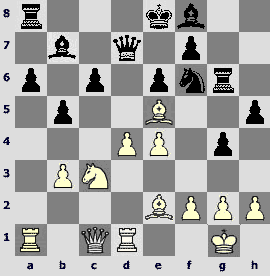
18.Ґxf6 In principle, an immediate c6-c5 was not a threat, so White has a spare move before starting a forced play. However, canyousuggestone? Maybe, 18.Јc2?
18...¦xf6 19.e5 ¦f5 The line 19...¦g6 20.Ґd3 f5 21.exf6 ¦xf6 22.¤e4± fails to please Black, so he puts a rook under attack in style of Tigran Petrosian, Sr. However, a tactical justification of this idea is not without flaws, as we shall see later.
20.Ґd3 Less clear is 20.¤e4 c5 (20...0-0-0 21.¤g3; 20...Ґe7 21.Јh6) 21.¤g3 Јd5 22.Ґf1 cxd4 23.¤xf5 exf5 24.Јc2
20...¦xf2!

The point!
21.Ґe4 The rook can be taken, but after 21.ўxf2 Јxd4+ 22.ўe2 Јxe5+ 23.¤e4 c5

White faces a problem: what he can do about the Black's pawns? Simplifying is dangerous: 24.Јc3 Јxc3 25.¤xc3 f5. However, it looks like White had a fantastic win: 21.Ґh7!! (protecting on d4) with the idea that is seen from the following variation: 21...¦f5 (21...¦xg2+ 22.ўxg2 c5+ 23.Ґe4) 22.¤e4
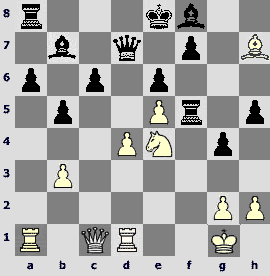
– threatening to take on f5 and play ¤f6+, and if Black defends against it, then take on f5 and ¤c5, smothering the b7-bishop, after which Black can only dream about any compensation for an exchange.
21...¦f5 22.Ґxf5 exf5 23.Јg5 Јe6

24.¦f1 Ґh6 25.Јxh5 0-0-0 25...Ґe3+ was playable: 26.ўh1 Ґxd4 27.¦ad1 (27.¦ac1 0-0-0) 27...0-0-0 (27...Ґxc3 28.Јh8+ ўe7 29.Јh4+=) 28.¤e2 Ґxe5
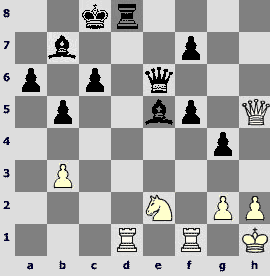
26.¤e2 Ґe3+ 27.ўh1 c5
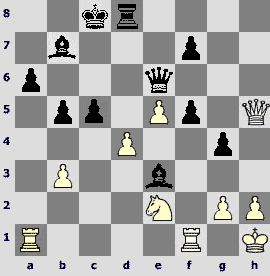
Instead of just taking on d4, Denis Yevseev preferred to carry out c6-c5 with the d4-pawn being alive. First of all, it results in his b7-bishop being more active, and, secondly, Black has some chances of creating a passer on the d-file.
28.¦xf5 28.dxc5 Ґe4µ …Јd5 or Јc6. 28.¤f4 is worthy of consideration 28...Ґxf4 29.¦xf4 ¦xd4 (29...cxd4 30.¦xf5 d3 31.Јxg4 d2 32.¦d1) 30.¦xd4 (30.¦xf5 Јd5-+ 31.¦g1 Јxg2+) 30...cxd4 31.Јh8+ ўd7 – Black has a decent counterchances.
28...cxd4 29.¦f6 Јxb3 30.¦xf7 ўb8 Here White decided to balance the game and returned the extra material.
31.¦xb7+ One should also consider 31.Јg6 with similar ideas: 31...d3 32.¦xb7+ ўxb7 33.Јxa6+ ўc7 34.Јa5+ Ґb6-+
31...ўxb7 32.Јh7+ ўb8 33.Јe7 Јd5 34.Јf6 ¦c8? 34...d3 is simpler and stronger, as I can't find how White can survive after it: 35.¤c3 (35.¤f4 Ґxf4 36.Јb6+ ўc8-+; 35.¤g3 ¦c8 36.Јxa6 d2-+) 35...Јd4 36.Јxa6 (36.¦xa6 ¦c8) 36...Јxc3 37.Јxb5+ ўc7, and White has no checks.
35.Јb6+ 35.Јxa6 led to a draw: 35...d3 36.¦b1 (36.¤f4 Јc6 37.Јxc6 ¦xc6 38.¤xd3 ўc7) 36...dxe2 37.¦xb5+ Јxb5 38.Јxb5+ ўa8 39.Јa4+ Ґa7 40.Јe4+ ўb8 41.Јb1+ ўa8=.
35...Јb7 36.Јd6+ ўa7 37.¤xd4
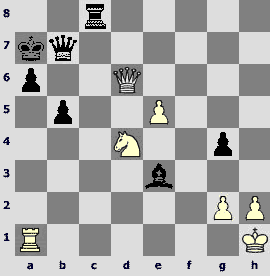
The main enemy of White is destroyed, now it is time for Black to defend.
37...¦c4 38.¤f5 Ґc5 39.Јd2 Јc6 40.¤d6 ¦d4 41.Јc3 ¦f4 Perhaps he should have given a rook for the knight - 41...b4 42.Јc2 ¦xd6 43.exd6 Јxd6 44.Јc4 (44.Јh7+ ўb6 45.Јg8 g3 46.Јa8 Јd3) 44...g3 45.h4 Ґf2.
42.¦c1 ўb6 43.Јb3 ўa7 Looks like time pressure moves – Black moves here and there just trying not to blunder anything. Instead of the text, he had a good resource 43...¦f2 44.Јg3 Јd5

– and White has to struggle for a draw, with all due respect.
44.Јd3 ўb6 45.¤f5 ¦f2 46.¤e3 ¦f7 47.¤xg4± The White's knight skillfully eaten up the Black's pawns. With his next move, Black blunders material, which causes immediate resignation.
47...Јd7 (47...¦d7) 48.Јg6+

…e5-e6. A very exciting game! From the opening point of view, it seems Black must looks for an improvement. 1-0
Some of the players have not played yet a single game with normal material balance.
Morozevich-Volokitin
XIII TCh-RUS Sochi RUS (2), 21.04.2006
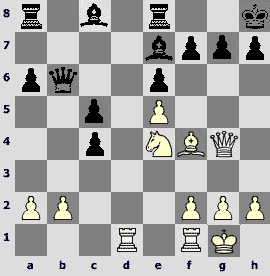
19.¦fe1 Simply leaving out a pawn.
19...Јxb2 20.Ґg5 ¦a7 21.Ґxe7 ¦axe7 22.Јh4
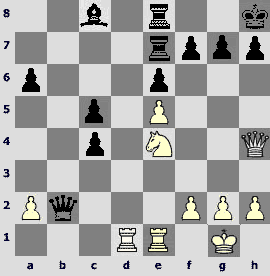
Morozevich skillfully fools the opponent – I guess 22.¤d6 ¦f8 23.Јxc4Іis objectively stronger.
After22.Јh4 White threatens to capture on e7 and play ¤d6.
22...f6?Black makes an error immediately. 22...¦d7 could have saved him – 23.¤d6 (23.¤f6 gxf6 24.Јxf6+ ўg8, and White must give the perpetual, as 25.¦xd7 is impossible: 25...Ґxd7 26.h4 Јc2 27.¦e3 Јf5-+; 23.¦xd7 Ґxd7 24.¤g5 Јc2 25.¤xf7+ ўg8 26.¤d6 ¦f8 gives Black a good counterplay; 23.¤g5 Јc2) 23...c3 (stronger than 23...¦f8 24.Јxc4 ¦c7, since now White will have to lose time on regaining both c-pawns) 24.Јc4 (threatening to take the rook; not good is 24.¤xe8 ¦xd1 25.¦xd1 c2 26.Јd8 cxd1Ј+ 27.Јxd1µ) 24...¦g8. Looks like the only move. Bad is 24...¦f8 25.Јxc5. Now 25.Јxc5 (25.¦b1 Јd2 26.¦ec1 Ґb7 27.Јxc5 Јg5 28.g3 Ґd5 29.Јxc3 Јh5„) 25...Ґb7 26.¦c1 f6 leads to an equal position.
23.exf6 gxf6 24.¦d2! Јe5 25.f4 Јf5 26.¤d6 Јg6 27.f5! , and the struggle is over: 27...Јg7 28.fxe6 c3 29.¦de2+- Ґb7 30.¤xe8 ¦xe8 31.Јh3 Јg5 32.e7 c4 33.Јd7 Јc5+ 34.¦f2 Јb5 35.Јd4 Јc6 36.Јxc3 ўg7 37.Јg3+ ўf7 38.Јh4 ўg7 39.¦e3 Јb6 40.¦g3+ 1-0
Morozevich-Moiseenko
XIII TCh-RUS Sochi RUS (1), 20.04.2006
1.e4 e5 2.¤f3 ¤f6 3.¤xe5 d6 4.¤f3 ¤xe4 5.d4 d5 6.Ґd3 Ґd6 7.0-0 0-0 8.¦e1 ¦e8 9.c4 c6 10.¤c3 ¤xc3 11.bxc3 ¦xe1+ 12.Јxe1 h6 13.¤e5 Ґe6 14.c5 Ґc7 15.f4 Јc8 16.¦b1 b5
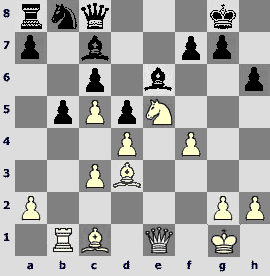
17.¦b2 Ґxe5 18.fxe5 Ґf5 19.Ґf1 ¤d7 20.Јg3 Ґg6 21.¦f2 ¤f8 22.Ґe2 a5
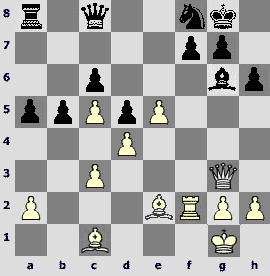
23.Ґxh6! gxh6 24.h4 Јd8 24...h5 25.Ґxh5 ўh7 26.Ґg4‚
25.¦f6 White correctly wants more than 25.h5 Јg5 26.Јxg5 hxg5 27.hxg6 ¤xg6 28.¦f5 b4„
25...ўh8 26.Јf4 ¤h7 27.¦xc6 b4 28.cxb4 axb4 29.Ґf3 ¦xa2 30.¦d6 Јg8 31.Ґxd5±
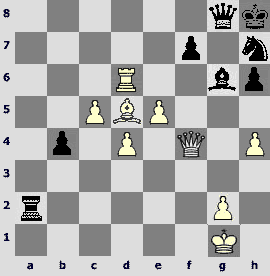
31...¦a1+ 32.ўh2 ¦e1 33.c6 b3 34.c7 Winning by force. Another possibility is 34.Ґxb3 ¦e2 (34...Ґe4 35.Јf2 ¦c1 36.Ґxf7+-) 35.Јg4+-. 34...b2 35.Ґa2 ¦c1 36.¦d8 ¦xc7 37.¦xg8+ ўxg8 38.e6+-

38...¦b7 39.Јe5 fxe6 40.Јxe6+ ўg7 41.Јg8+ ўf6 42.Јh8+ ¦g7 43.Јd8+
43.Јd8+
A) 43...ўf5 44.Јd5+ ўg4 (44...ўf6 45.Јe5#) 45.Јf3+ ўxh4 46.g3+ ўg5 47.Јf4+ ўh5 48.Јh4#;
B) 43...¦e7 44.Јd6+ 1-0
Movsesian-Morozevich
XIII TCh-RUS Sochi RUS (3), 22.04.2006
1.e4 c5 2.¤f3 d6 3.d4 cxd4 4.¤xd4 ¤f6 5.¤c3 ¤c6 6.g3 g6 7.¤de2 Ґg7 8.Ґg2 0-0 9.0-0
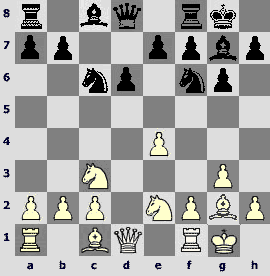
Well, I am not trying to offend, but one must mention that there are more ambitious setups in chess.
9...Ґg4 10.h3 Ґxe2 11.¤xe2 ¤d7 12.¦b1 ¦b8 13.a4 b5 14.axb5 ¦xb5 15.b3 a5 16.Ґe3 Јb8
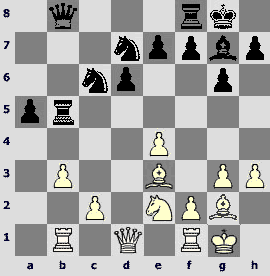
Alexander Morozevich is a mystery man. Who can tell for sure whether he sacrificed or just overlooked White's next move?
17.e5 ¦c8 18.Ґxc6 ¦xc6 19.¤d4 ¤xe5 20.c4 ¦bb6 21.¤xc6 ¦xc6 22.Ґd4 Јc8 23.ўg2 Јb7 Normal reaction is 23...¤d7, but in this case after 24.Ґxg7 ўxg7 25.Јe1 the a5-pawn is weak.
24.Ґxe5 Ґxe5 25.Јf3

25...Јc8 26.¦fd1 Јa6 27.¦d2 Јb6 28.Јe4 e6 29.¦bd1 ўg7 30.¦d3 , and White converted his small material advantage. 1-0
Positional sacrifices
Moiseenko-Ivanchuk
XIII TCh-RUS Sochi RUS (3), 22.04.2006
A short, but very curious positional game by Vassily Ivanchuk. 1.d4 e6 2.c4 ¤f6 3.¤c3 Ґb4 4.g3 d6 5.Ґg2 ¤bd7 6.¤f3
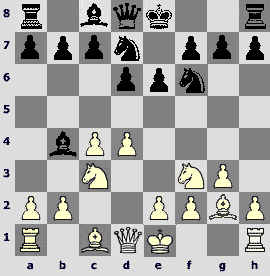
6...Ґxc3+ 7.bxc3 ¦b8!? 8.0-0 b6 9.Јa4 0-0!? (a sacrifice that reminds of a famous Taimanov-Karpov game) 10.Јxa7 Ґb7 11.Јa4 ¦a8 12.Јb3 ¦a5 13.¤e1 Јa8
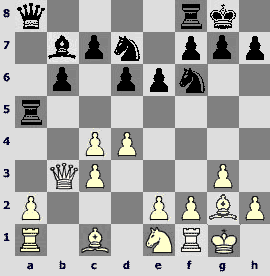
A draw agreed. Well, not all short draws are dull.1/2-1/2
Here is the reference game.
Taimanov-Karpov
Moscow-3teams Moscow (1.1), 24.04.1973
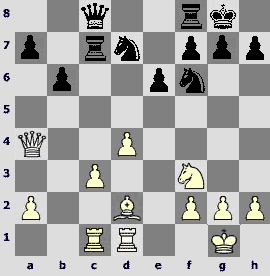
17...¦c4 18.Јxa7 Јc6 19.Јa3 ¦c8 20.h3 h6 21.¦b1 ¦a4 22.Јb3 ¤d5 23.¦dc1 ¦c4 24.¦b2 f6 25.¦e1 ўf7 26.Јd1 ¤f8 27.¦b3 ¤g6 28.Јb1 ¦a8 29.¦e4 ¦ca4
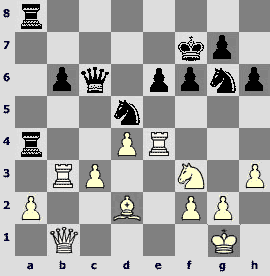
30.¦b2 ¤f8 31.Јd3 ¦c4 32.¦e1 ¦a3 33.Јb1 ¤g6 34.¦c1 ¤xc3 35.Јd3 ¤e2+ 36.Јxe2 ¦xc1+ 37.Ґxc1 Јxc1+ 38.ўh2 ¦xf3 39.gxf3 ¤h4 0-1
Харлов – Попов
XIII TCh-RUS Sochi RUS (1), 20.04.2006
1.e4 c5 2.¤f3 d6 3.d4 cxd4 4.¤xd4 ¤f6 5.¤c3 a6 6.Ґe3 ¤g4 7.Ґc1 ¤f6 8.Ґe2 e5 9.¤b3 Ґe7 10.0-0 0-0 11.¦e1 b6 The main line here is 11...Ґe6 12.Ґf1 ¤bd7 13.¤d5 ¤xd5 14.exd5 Ґf5 15.a4 ¦c8.
In my opinion, b7-b6 here is not best, contrary to the main line with 9.ўh1.
12.Ґg5 Ґb7 13.Ґxf6 Ґxf6 14.Ґc4 ¤c6 15.Ґd5 Ґg5 16.a3 Јc7 17.Јd3 g6 18.¦ad1 ¦ad8 19.¤a2 ¦d7 20.¦e2 ўg7 I prefer 20...ўh8 with the same idea – who knows, maybe after f7-f5 it will be possible to move the rook from d7 to g7.
21.¤b4 ¤xb4 22.axb4 Ґc8 23.c3 ¦dd8 24.¤a1 f5 25.exf5 gxf5 26.¤c2 ¦f6 27.b5 a5 28.Ґc6
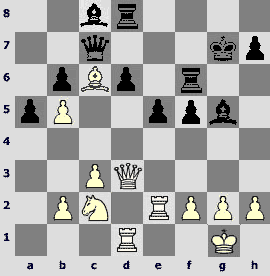
28...f4 There is no standard Sveshnikov 28...d5 in view of 29.Јg3+-
29.c4 Ґg4
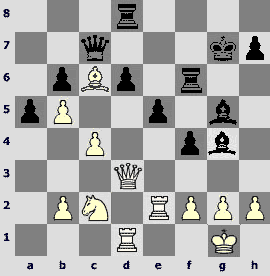
30.¤e1 Ґxe2 31.Јxe2 ўh8 32.¤f3 Јg7 33.Ґe4
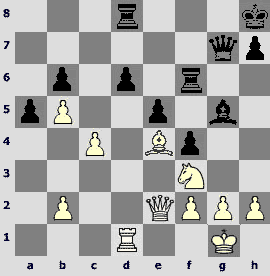
What can be said about the resulted position?
1) If White just stands on light squares, he can not lose. Actually, despite the material deficit, it is White who plays for a win.
2) Black has extremely solid dark squares. Objectively, he should be able to hold the position.
3) So far White must bring the knight to e4 or d5, and then think about a b2-b4 break.
33...¦c8 34.¦d5 I don't think having a rook on d5 makes sense. 34.Ґc6!? …¤d2-e4
34...Ґh6 35.Јd3 ¦g8 36.¤e1 36.¤d2 is met by 36...f3! 37.g3 (37.Ґxf3 Ґxd2 38.Јxd2 ¦xf3-+) 37...Ґxd2 38.Јxd2 Јg4µ , so the knight has to make a detour.
36...Јc7 Here Black has no tactical blows after 36...f3 37.Ґxf3, so he must continue moving here and there
37.b3 Ґf8 38.ўf1 Јg7 39.h3 Ґe7 40.Ґf3 ¦c8 41.Јe2 Ґf8 42.¦d1 Ґe7 43.Ґd5 ¦g6 44.¤c2 ¦g8 45.Јf3 ¦f8 46.ўg1 Ґh4 47.Ґe4 ¦h6 48.¤e1 Јc7 49.Јe2 ¦g8 50.¤d3 Ґd8 51.Јf3 Јc8 52.ўh2 Ґc7 53.¤b2
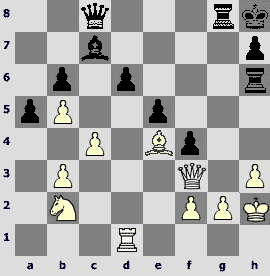
The knight finally comes towards the d5-square (via a4 and c3).
53...Јg4 I think Black would survive if he hadn't swapped the queens. 54.Јxg4 ¦xg4 55.¦d5

55...f3!? A pawn sacrifice that unblocks the files for Black pieces. 56.Ґxf3 ¦gh4 (56...¦d4) 57.ўg1 ¦f4 58.¤d3 ¦f8 59.Ґe4 ¦h4 60.f3 ўg7 61.¤f2 ¦hf4 62.¤d1 h5 63.¤c3 h4 64.¦d3 ¦4f7 65.ўf1 ўh6 Black voluntarily gives the opponent tactical chances linked with ¤d5, followed by a sac on b6 and a check from d6. And I think he perfectly realized it. 66.¤d5 Ґd8 67.¤e3 Ґc7 68.¤d5 Ґd8
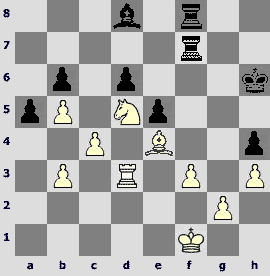
69.b4 ¦a7 [69...axb4 70.¤xb4] 70.bxa5 ¦xa5 71.¤xb6 ¦a1+ 72.ўe2 ¦a2+ 73.ўd1 Ґxb6 74.¦xd6+ ўg5 75.¦xb6 ўf4
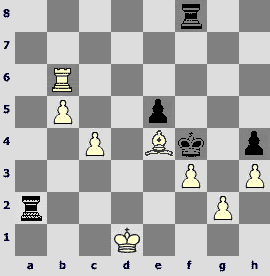
White had to accept a messy position in order to play for a win. He has excellent passed pawns on the queenside, however, his king is just ugly, especially compared to the Black's monarch.
76.¦d6 ¦c8 77.Ґd5 ¦c7 In order to have the opportunity to transfer the rook to a- and g-files.
78.¦f6+? An impulsive check, after which the assessment of the position changes completely. Correct was 78.¦g6!, depriving Black of the idea ¦g7xg2, after which the game could continue as follows: 78...¦ca7™ (78...ўe3 79.b6) 79.ўc1 ¦7a3 80.c5 ¦c3+ 81.ўb1 ¦d2 – Black's counterplay should be sufficient for a draw.
78...ўe3 79.f4?

This move is explained by the line 79.b6 ¦g7, and White, in order to avoid getting mated, has to play 80.f4 (80.b7 ¦gxg2) 80...e4 81.¦e6 ¦gxg2 82.¦xe4+ ўd3 83.¦e3+ ўxe3-+ 84.Ґxg2 ¦xg2 85.c5 ¦d2+ 86.ўc1 ¦d5-+. The only move that keeps White in the game is 79.ўc1 ¦g7 80.f4 e4 81.c5 ¦axg2 82.¦e6 ўd4 83.Ґxe4 ¦f2 84.Ґg6.
79...ўd3?? 79...¦d2+! 80.ўe1 ¦xd5-+
80.¦a6± ¦a7 81.¦xa7 ¦xa7 82.ўc1

82...e4 [82...ўc3 83.ўb1 exf4 84.b6 ¦a4 85.c5 ¦b4+ …86.ўc1 ўd4 87.c6 ўxd5 88.c7 ¦c4+ 89.ўd2 ўd6-+] 83.b6 ¦a4 84.b7 ¦b4 85.c5 ўd4 86.c6 ўc3 1-0
Khairullin-Bologan
XIII TCh-RUS Sochi RUS (3), 22.04.2006
1.e4 c6 2.d4 d5 3.e5 Ґf5 4.¤f3 e6 5.Ґe2 ¤d7 6.0-0 h6 7.¤bd2 ¤e7 8.c3 a6 9.¤e1
It is difficult to comment the White's knight maneuvers not being an expert in the 3.e5 variation. Morozevich was less subtle in San Luis against Anand, preferring 9.¤b3.
9...c5 10.¤df3 ¤c6 11.a3 c4 12.¤c2 Ґe7 13.¤e3 Ґh7 14.¤d2 0-0 15.f4 ўh8 16.Јe1 [16.f5 Јb6] 16...f6 17.Ґg4 fxe5 18.fxe5 ¤dxe5 19.dxe5 ¤xe5

20.¦xf8+ Too dangerous is 20.Ґxe6 ¤d3 (20...Јb6) 21.Јe2 (21.Јg3 Ґd6 22.Јh3 ¦xf1+ 23.¤dxf1 ¤f4 24.Јg4 h5) 21...Ґc5 22.b4 Ґa7 – White must keep the e-file closed.
20...Ґxf8 21.Ґe2 Ґc5 22.¤df1 Јb6 23.ўh1 ¦f8
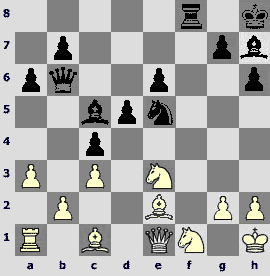
24.¤d1 ¤c6 [24...¤d3 25.Ґxd3 Ґxd3 26.¤g3] 25.Ґe3 Ґxe3 26.¤fxe3 ¤a5! If I had an opportunity to color a diagram, like in ChessBase, I'd paint half of the White's pieces red: the a1-rook, both knights and the bishop.
27.a4 ¤b3 28.¦a3
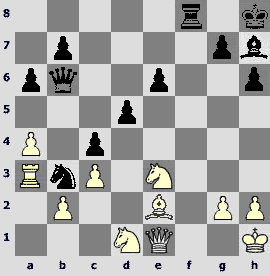
To be honest, the rook is not very well placed here. Later White will have to put some effort into freeing it.
28...Ґe4 29.¤g4 a5 30.¤gf2 Ґc2 31.Ґf3 ¤c5 32.Јe3 Јd6 33.¦a1 ¤b3 34.¦a3 e5 35.Јe2 Ґh7 36.ўg1
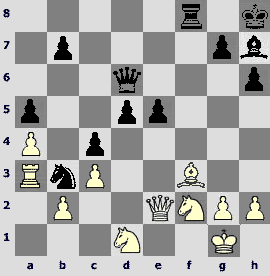
Black's next move is very revealing: 36...b6 – no rush!
37.Ґg4 Ґg8 38.¤e3 Јg6 39.¤ed1 d4 40.Ґf3 Јg5 41.Ґe4 ¤c1 42.Јe1 d3 43.Јe3 ¤e2+ 44.ўf1 Јh4 45.h3 ¤g3+ 46.ўg1 ¦f4 47.Ґf3 e4 48.Ґg4 h5 49.Ґc8 Ґd5 50.Јxb6
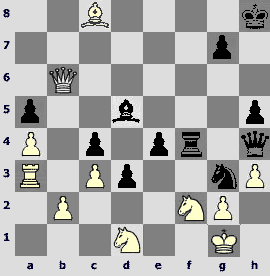
Better is 50.¦a1, as the pawn capture meets a tactical refutation.
50...e3! 51.Јxe3 (51.¤xe3 ¤e2+-+) 51...Јg5 There is no defense against a check from e2 followed by capturing on g2.
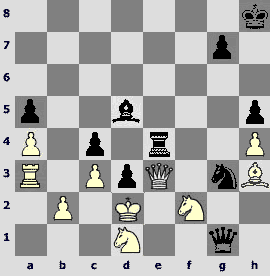
57.¤xe4 ¤xe4+ 58.ўc1 Јh2 59.¤f2 d2+ 60.ўc2 ¤xf2 61.Јe8+ Ґg8 62.ўxd2 ¤xh3+ 63.ўc1 ¤f4-+ 64.ўb1 Јh1+ 65.ўc2 Јg2+ 66.ўb1 Јf1+ 67.ўa2 Јd1 0-1
Ivanchuk-Aronian
XIII TCh-RUS Sochi RUS (2), 21.04.2006
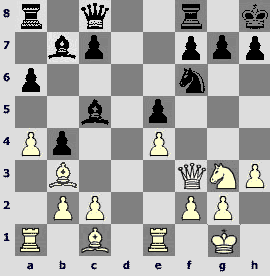
16...¤xe4?! Aronian's generous nature proves excessively generous in this case.
17.¤xe4 f5 18.¤xc5 Ґxf3 19.gxf3 f4 20.ўh2 Јf5 21.Ґd2 ¦f6 22.¦g1 ¦h6 23.¦g4 a5 24.¦e1 ¦f8 (24...Јh5 25.h4)
25.¤e4 Јh5 26.h4 ¦g6 27.¦xg6 Јxg6 28.c3 c5 In my opinion, 28...Јh5 gives more practical chances, for instance, 29.cxb4 axb4 30.ўg2 (30.a5) 30...Јg6+ 31.ўf1 Јa6+ 32.¦e2 Јd3
29.¤xc5 ¦d8 30.¤e4 Јb6 31.¦d1 ¦d3 (31...bxc3 32.Ґxc3) 32.Ґc4 ¦xf3 33.Ґe1 g5 34.hxg5 ўg7 35.¦d7+ ўf8 36.¦f7+ ўe8 37.¦f6+- 1-0
Here is another game featuring the Slav gambit, which clearly comes into fashion.
Riazantsev-Galkin
XIII TCh-RUS Sochi RUS (3), 22.04.2006
1.d4 d5 2.c4 e6 3.¤c3 c6 4.e4 dxe4 5.¤xe4 Ґb4+ 6.Ґd2 Јxd4 7.Ґxb4 Јxe4+ 8.Ґe2 ¤a6 9.Ґd6 e5 10.¤f3 Ґg4 11.0-0 0-0-0 12.b4!?The move recently introduced by Shakhriyar Mamedyarov. According to present-day knowledge, 12.Ґd3 leads to a dead draw after 12...Јf4 13.Ґxe5 Јxe5 14.¤xe5 Ґxd1 15.¦axd1 ¤h6.
After the text-move everything is either forced or logical until the 21st move. 12...¤f6 13.¦e1 Ґxf3 (13...¤xb4 14.¤d2 ¦xd6 15.¤xe4 ¦xd1 16.Ґxg4+ ¤xg4 17.¦axd1) 14.Ґxf3 Јxc4 15.¦xe5 ¤xb4 16.¦e7 ¤bd5™ 17.¦c1 Јh4 18.g3 Јh3 19.Ґxd5 ¦xd6 20.Јb3 ¤d7 (20...¦d7 21.Ґxc6+-) 21.Ґg2 The players repeat Mamedyarov-Tregubov, Reykjavik, 2006, but now Black deviates.
21...Јh5 Tregubov played 21...Јh6 22.¦b1 b6 23.Јa3 a5 24.Ґh3 (attacking on b6) 24...c5 25.Ґg4 Јf6? (better is 25...¦d8, but lack's position is hardly enviable) 26.¦xd7 ¦xd7 27.¦d1 ¦hd8 28.Јa4 , and Black resigned.
22.h4!? …Ґh3 22...¦d8 It is interesting to consider 22...g5 with the following rationale: White wanted to play Ґg2-h3 on the previous move, and now we can meet t with g5-g4; and it is clearly better to exchange the g7-pawn rather than to lose it. However, all these advantages are abolished by shutting off the queen on h5: 23.¦b1 ¤b6 (23...b6 24.¦be1‚ …Јa3) 24.Јa3 ¦d1+ 25.ўh2 ¦xb1 26.Јd6 ¤a8 27.Јe5! ¦f8 28.Ґh3++-.
23.¦xf7 Јg6 24.¦e1 ¦f6 25.¦fe7 ўb8 26.¦d1 ¦d6 27.¦xd6 Јxd6 28.¦xg7 h6 29.Јf7 a5 30.¦h7± (Black can't save the h-pawn) 30...a4 31.Јg7 a3 32.¦xh6 Јd2 33.¦h8 ¦xh8 34.Јxh8+ ўa7 35.Јg8 Јc2 36.Јe6 ¤b6 37.Ґf1 c5 38.h5 c4 39.Јe2 Јb1 40.h6 c3 41.Јd3 Јb2 42.h7 c2 43.h8ЈЈxh8 44.Јxc2 Јb2 45.Ґd3 Јb4 46.ўg2 ¤d7 47.Ґe4 ¤c5 48.Ґf3 Јd4 49.Јc1 Јb4 50.Јe3 ўb6 51.g4 Јb2 52.Ґd5 ўb5 53.g5 b6 54.g6 Јf6 55.Јg3 Јg7 56.Ґf7 ўb4 57.Јf4+ ўa5 58.Јd2+ ўb5 59.Јe2+ ўa5 60.Ґe8 Јb2 61.Јb5+
The game confirmed quality of Mamedyarov's idea. Black did not lose quickly, but a loss of all kingside pawns can hardly be regarded as an achievement. 1-0
Maneuvers
Aronian-Tiviakov
XIII TCh-RUS Sochi RUS (3), 22.04.2006
1.c4 e5 2.g3 ¤f6 3.Ґg2 d5 4.cxd5 ¤xd5 5.¤c3 ¤b6 6.d3 Ґe7 7.Ґe3 0-0 8.¦c1 ¤c6 9.¤f3 Ґe6 10.0-0 ¤d5 11.¤xd5 Ґxd5 12.Јa4 a6 13.a3 Ґd6 14.¦c3 ¤e7 15.Јh4 f6
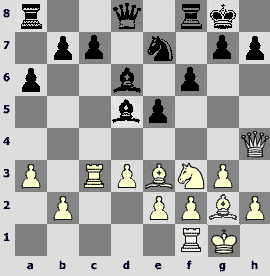
For someone not very familiar with the English Opening, Black has a good game – he removed the knight from the c-file, strengthened the center, etc.
16.¤d2 A standard move so far.
16...c6 17.¤c4 Ґc7 18.Ґe4 ¤g6 19.Јh3 ¦f7
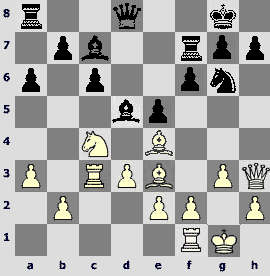
…¤f8. And here comes a disarming knight maneuver that follows the principle "retreat in order to move forward!".
20.¤d2 ¤f8 21.¤b3 Here Black applied mass exchanges, after which he had to struggle for a draw. I don't think it was forced, though.
21...Ґxe4 22.dxe4 Јd7 23.Јxd7 ¤xd7 24.¦d1 ўf8 25.¦cd3 ўe8
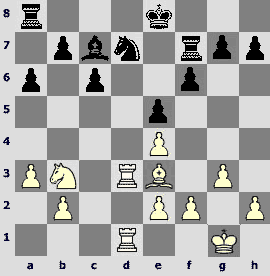
26.¤d2 Aronian returns the knight to c4 with light heart: the knight aims at d6.
26...ўd8 27.¤c4 ўc8 28.¦c3 a5 29.a4 ¦e7 30.h4 b6 31.¦cd3 ¦b8 32.h5 h6 33.ўg2 b5 Black should have kept a low profile: 33...¤f8!? …¤e6 34.¦b3 (34.¤d6+ Ґxd6 35.¦xd6 ўc7 …¦d7) 34...b5
34.axb5 ¦xb5 35.¦c3 ўb7 36.b3 ¦b4 37.¦a1 ¦b5 38.¦d1 ¦b4
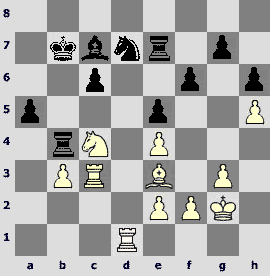
39.Ґc1± c5 40.¦cd3 ўc6 41.Ґd2 ¦b5 42.¦a1 f5 43.exf5 e4 44.¦c3 Ґe5 45.¤xa5+ Approaching the 5th rank nearly for the first time in the game.
45...ўc7 46.Ґf4 Ґxf4 47.gxf4 ¤f6 48.e3 ¤xh5 49.b4 ¦xb4 50.¦xc5+ ўb6 51.¦c6+ ўb5 52.¦c8 1-0
Zvjaginsev-Ponomariov
XIIITCh-RUSSochiRUS (1), 20.04.2006
1.e4 c5 2.¤a3
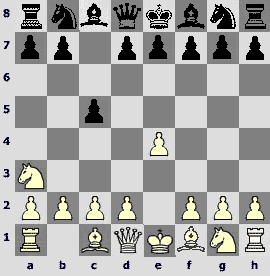
2...¤c6 3.Ґb5 g6 4.c3 Ґg7 5.d3 ¤f6 6.f4 0-0 7.¤f3 d6 8.0-0 Ґd7 9.Јe1 e6 10.Јh4 ¤h5 11.g4 Јxh4 12.¤xh4 Ґf6 13.¤xg6 hxg6 14.gxh5 gxh5
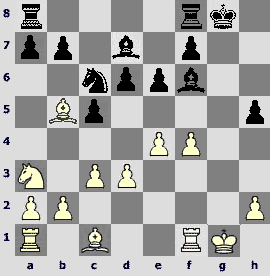
If you haven't seen White's next two moves, you will hardly guess them right!
15.Ґa4!? d5 16.Ґd1
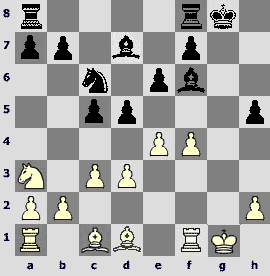
Clearly, Ponomariov was so unhappy with placing a pawn to h4 that he decided to undertake a dubious central activity.
16...c4 17.e5 Ґe7 18.dxc4 d4 19.¤c2 dxc3 20.bxc3 ¤a5 21.Ґa3 Ґxa3 22.¤xa3 ¦ac8 23.Ґe2 f6 24.¦ad1 Ґe8 25.f5
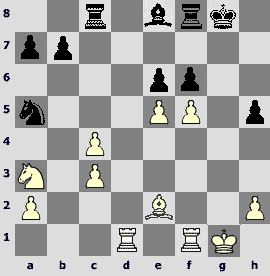
25...fxe5 26.fxe6 ¦xf1+ 27.¦xf1 ўg7 28.Ґf3 b5 29.cxb5 ¦xc3 30.¤b1 ¦c5 31.Ґe2 e4 32.ўf2 e3+ 33.ўxe3 ¦e5+ 34.ўf3 Ґxb5 35.Ґxb5 ¦xb5 36.¦e1 ¦f5+ 37.ўg3±
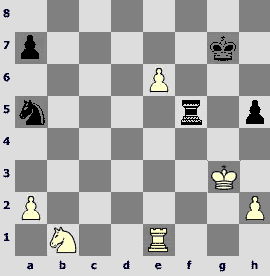
37...ўf8 38.¤d2 ўe7 39.¤f3 ¦d5 40.ўh4 ¤c4 41.¤g5 ¦d2 42.¦c1 ¤d6 43.h3 ¤e8 44.ўxh5 ¦xa2 45.ўg6 ¦a4 46.¦b1 ¤d6 47.¦b8 ¦f4 48.¦a8 ¦f6+ 49.ўh5 ¤b5 50.h4 ¦f4 51.¦h8 ¤d6 52.¦h7+ ўe8 53.¦xa7 ¤f5 54.¤h7 ¤d4 55.ўg6 ¤xe6 56.¤f6+ ўd8 57.¦a8+ ўc7 58.¤d5+ 1-0
Surprises
Dreev-Tregubov
XIII TCh-RUS Sochi RUS (2), 21.04.2006
1.d4 ¤f6 2.¤f3 c5 3.d5 b5 4.Ґg5 Јb6 5.¤c3 b4 6.¤a4 Јa5 7.b3 ¤e4 8.Ґf4 d6 9.¤d2 ¤xd2 10.Јxd2 h6 11.a3 ¤a6 12.axb4 Јxb4 13.c3! Јxb3 14.e4 g5
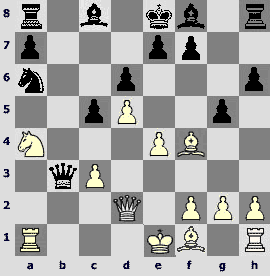
15.Ґe5! dxe5 16.Ґxa6 Ґxa6 17.¤xc5 Јc4 18.¤xa6 Јxe4+ 19.Јe2 Јxe2+ 20.ўxe2 ¦c8 21.¦hb1 Ґg7 22.¤b8 ¦c7 23.¤c6 e4 24.¦xa7 ¦xa7 25.¤xa7 0-0 26.¤c6± 1-0
Bologan-Volkov
XIII TCh-RUS Sochi RUS (2), 21.04.2006
1.e4 e6 2.d4 d5 3.¤c3 ¤f6 4.e5 ¤fd7 5.f4 c5 6.¤f3 ¤c6 7.Ґe3 Јb6 8.¤a4 Јa5+ 9.c3 c4 10.b4 Јc7 11.g3 Ґe7 12.Ґh3 ¤f8 13.0-0 b6 14.Ґg2 Ґd8 15.¤b2 ¤e7 16.a4 a6 17.¤d2 ¦a7 18.Јe2 b5 19.Ґf2 Ґd7 20.g4 h5 21.gxh5 a5 22.axb5 Ґxb5 23.bxa5 ¦xa5 24.¦fb1 ¤f5 25.¤d1
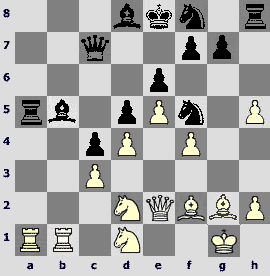
25...g6! 26.hxg6 ¤xg6 27.Ґg3
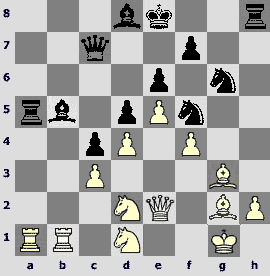
27...¤xd4 28.cxd4 c3 29.Јf2 c2 30.¤b3
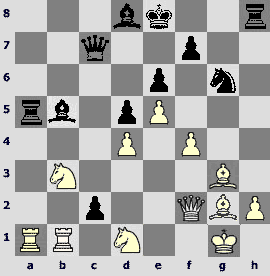
[30.¦c1 ¦xa1 31.¦xa1 c1Ј-+] 30...¦a2!! 31.Јf3 cxb1Ј 32.¦xb1 Ґe2 33.Јe3 Ґxd1 34.¦xd1 Јc2µ with the advantage that is close to decisive. 0-1
Shirov-Naiditsch
XIII TCh-RUS Sochi RUS (2), 21.04.2006
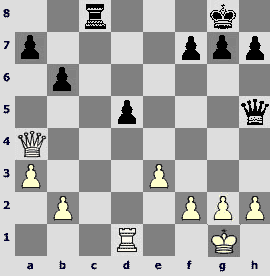
24.g4! Јg5 25.¦d4 h5 [25...Јf6 26.Јd7 (26.Јxa7 Јf3) ; 25...a5 26.Јd7 ¦d8 27.Јc6] 26.Јxa7 hxg4 27.Јd7 ¦c1+ 28.ўg2 ¦c2 29.Јe8+ ўh7 30.Јxf7 Јe5 31.¦xd5 A surprisingly quick solution of the technical position on the diagram above.1-0
Unusual positions
Bologan-Tomashevsky
XIIITCh-RUSSochiRUS (1), 20.04.2006
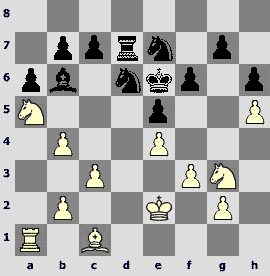
In this game a highly unusual endgame pattern arose.
26.¤f1 Ґxa5 27.¦xa5 ¤c4 28.¦a1 f5 29.b3 ¤d6 30.exf5+ ¤dxf5 31.Ґd2 ¤d5 32.g4 ¤d6 33.c4 ¤f4+ 34.Ґxf4 exf4 35.¦d1 ¦e7 36.¦d4

Black messed up somewhere, so now he has to hold onto a weakness on f4 as hard as he can.
36...ўf6+ 37.ўf2 ўg5 38.¦d5+ ўh4 Forced: 38...ўf6 39.c5±
39.¦d4 ўg5 40.¦d5+ ўh4 41.¤d2 ¤f7 42.¤e4 ¤e5 43.¦d4 [43.¦d1? ¤xg4+] 43...b6 [43...¦d7 44.¦xd7 ¤xd7 45.ўg2] 44.c5 ўh3 45.¤c3 ўh2
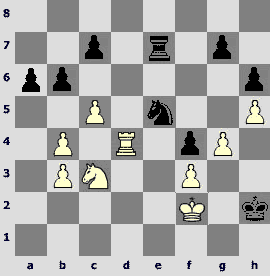
The king is strong in the endgame!
46.¤e2 ¤f7 47.¤xf4 ¤g5 48.c6 My computers considers 48.¦d2 being the most accurate, in order to gain a tempo on a discovered check ўe3: 48...¦e8 (48...¦f7 49.ўe3+ ўg3 50.¤e2+ ўh3 51.¤d4 is very good for White) 49.¦e2 ¦f8 50.ўe3+ ўg3 (50...ўg1 51.¦g2+ ўf1 52.¦f2+ ўg1 53.¤e2+ ўh1 54.¤d4) 51.¦g2+ ўh4 52.¤g6+.
48...¦f7 And now it is not clear how to retreat from f4 – ўe3 is met by ¦e7+, and the king has to return. White has to find a proper moment for ўe3.
49.ўe3 ¦e7+ 50.ўf2 ¦f7 51.¦c4 b5 52.¦d4 ¦f6 How to win after 52...¦f8 ? I can't see: 53.¤d5 (53.ўe3 ¦e8+ 54.ўd3 ¤xf3) 53...¤xf3 54.¦f4 (54.¦d1 ¤d4+) 54...¦xf4 55.¤xf4 ¤e5 56.¤e6 ¤xc6 57.¤xg7 ¤e5.
53.ўe3 ўg3 54.¤e2+ ўg2 55.¤f4+ ўg3 56.¤e2+ ўg2 57.f4 ¦e6+ 58.ўd3 ¤f3 58...¤h3!? …59.¦d7 ¤f2+ 60.ўd2 ¤e4+=
59.¦d7 ¦xc6 Black should have tried 59...ўf2!? 60.¤d4 (60.¤c3 ¤e1+ 61.ўd4 ¦xc6 62.¤d5 ¤f3+ 63.ўe4 ¦e6+ 64.ўd3 ¦d6 65.¦xd6 cxd6 – I don't think the resulting knight ending is bad for Black, for instance, 66.ўe4 ўg3 67.¤c7 ўxg4 68.¤xa6 d5+ 69.ўxd5 ўxh5) 60...¦e3+ 61.ўc2 ¤xd4+ 62.¦xd4 ¦e6 63.¦d7 ¦xc6+ 64.ўb2 g6 (64...ўf3) 65.¦g7 gxh5 66.gxh5 ¦f6 67.¦g6 ¦xf4=.
60.¦xg7 ¦d6+ 61.ўc3 ўf2 62.¦e7 ¦c6+ 63.ўb2 ¦f6 64.f5 ¤g5 65.¤c3 ўf3 66.¤d5 ¦d6 67.¤xc7 ўxg4 68.¤e8 (defending pawns in time) 68...¦d8 69.¤g7 ¦f8 70.ўc3 ¦f7 71.¦xf7 ¤xf7 72.ўd4 ўg5 73.ўe4 ўf6 74.¤e8+ ўg5 75.f6
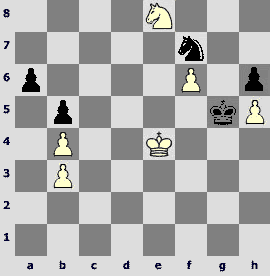
75...ўg4 One cannot take on h5: 75...ўxh5 76.ўf5+-. Black is lost.
76.¤c7 ўg5 77.¤d5 ўg4 78.¤e7 ўg5 79.¤g8 ўg4 80.ўd5 ўf5 (80...ўxh5 81.ўe6 ¤g5+ 82.ўf5 ¤f7 83.¤e7) 81.ўc6 ўg5 82.ўd7 ўxh5 83.ўe6 ¤d8+ 84.ўe7 ¤c6+ 85.ўe8 1-0
Grischuk-Tiviakov
XIII TCh-RUS Sochi RUS (1), 20.04.2006
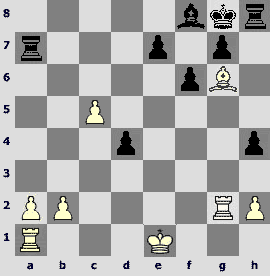
The players agreed to a draw here. 1/2-1/2.
I shall conclude the article with a few more curious examples of the starting rounds' games.
Najer-Jakovenko
XIII TCh-RUS Sochi RUS (2), 21.04.2006
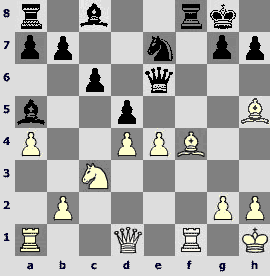
20.exd5 ¤xd5 21.¤xd5 Јxd5 22.Ґf3 Јd8 23.Јb3+ ўh8 24.Ґg3
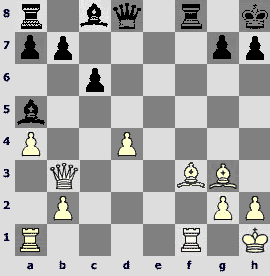
24...Јxd4 [24...Ґb6 25.d5±] 25.Ґxc6 Ґg4 26.Јxb7 ¦ad8 27.h3 ¦xf1+ 28.¦xf1 Ґe2
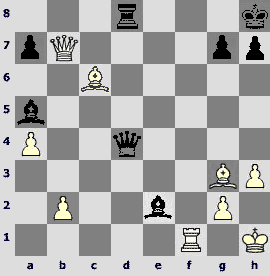
29.Јe7! Ґxf1 30.Ґe5 Ґxg2+ 31.ўh2 Јxe5+ 32.Јxe5 Ґxc6 33.Јxa5 ¦d7 34.Јc5 ¦d2+ 35.ўg1 Ґd5 36.b4 1-0
Eljanov-Jakovenko
XIII TCh-RUS Sochi RUS (1), 20.04.2006

With all benefits of the open g-file, White risks more in this position due to a weakness on c4.
25.Ґh2 ¤c6 26.¦g6
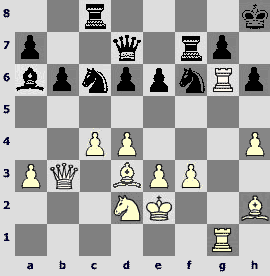
26...e5 27.d5 ¤a5 28.Јb4 ¦c5 29.e4 Јc8 30.¦c1 Јh3 31.Ґg1

31...ўh7 [31...¤h5!?] 32.Ґxc5 dxc5 33.¦xf6 gxf6 34.Јa4 ¦g7 35.ўd1 Ґc8 36.Јe8 Ґd7 37.Јh5 Ґa4+ 38.ўe1 Јg3+ 39.ўe2 Јh2+
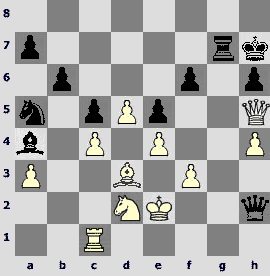
40.ўe1 Јg3+ 41.ўe2 Јh2+ 42.ўe1 Ґd7 0-1
Timofeev-Landa
XIII TCh-RUS Sochi RUS (3), 22.04.2006
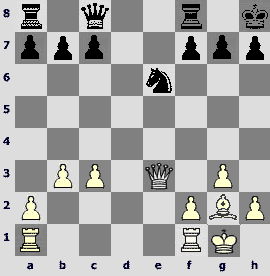
21.f4 f5 Preventing f5-f6. Black's position after 21...¦e8 22.f5 ¤f8 23.Јf3 c6 24.f6± is very unpleasant.
22.¦fe1 ¦f6 23.¦ad1 ¤f8 24.Јe7 c6 25.b4 a6 26.h4 Јb8 27.c4 Јa7+ 28.c5 a5 29.b5+- ¤g6 , and a simple finishing combination follows, reminding of the Rink's study: 30.¦d8+ ¦f8 31.b6 Јa6 32.¦xf8+ ¦xf8 33.Јxf8+ ¤xf8 34.¦e8 ўg8 35.Ґf1
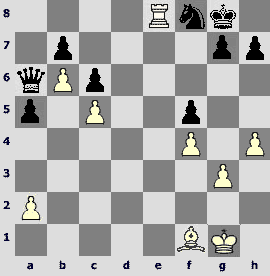
35...ўf7 36.¦xf8+ ўxf8 37.Ґxa6 Black resigns.1-0
Shaposhnikov-Nepomniachtchi
XIII TCh-RUS Sochi RUS (1), 20.04.2006
1.e4 c5 2.¤f3 d6 3.Ґb5+ ¤d7 4.0-0 ¤gf6 5.d4 cxd4 6.Јxd4 e5 7.Јd3 h6 8.c4 Ґe7 9.¤c3 0-0 10.Ґe3 a6 11.Ґa4 Јa5 12.b4

12...Јd8 One can't take the pawn: 12...Јxb4 13.Ґxd7 Ґxd7 14.¦fb1+-; 12...Јc7 13.¦ac1 …¤d5; thus it is better to retreat at once.
13.¤h4 ¤b6, and Black, having recognized his error, managed to hold this game to a draw. 1/2-1/2
